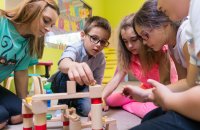Helping Students Develop Self-Regulation
Guiding students to create an ongoing cycle of growth in self-regulation starts with having them set explicit goals for themselves.
Self-regulation is a skill that takes a long time to learn and may take a lifetime, in truth, to really master. We can get better at it with practice, and our students’ social, emotional, and character development requires that we provide routine opportunities in classrooms and schools for them to work on this skill.
Developing self-regulation as a skill is for everyone, not just those who are experiencing difficulty in some area of their life. The concept here is one of continuous improvement. Self-regulation means identifying and taking steps to help one get better at things that are important for that person’s individual development. Everyone, at all ages, no matter their degree of accomplishment or shortcoming, can participate in an improvement process.
Setting a Goal
In helping students learn to self-regulate, consider following these five steps, which are to be repeated in an ongoing cycle for continued growth and improvement.
- Have students determine their goal—the aspect of self-regulation they’d like to improve. You can ask them to work on up to two out of the four areas below at any given point in time.
- Have them create a plan for how they will improve in that area in the short term.
- Ask students to review their goal and plan with a classmate who will act as their support partner and then get final approval from their support team—a small group that includes classmates and you.
- Students should periodically evaluate the plan against the goal they set and determine whether their plan needs adjustment. They should finalize this adjustment after review and approval by their support team.
- When students meet one goal, have them set another and create a new plan to share with the support team.
Four Areas for Self-Regulation Improvement
While improvement plans can be made in any area, I suggest focusing on study skills, social and emotional competency, physical health, or citizenship. I’ve designed improvement plan worksheets for these four areas.
Study skills: Everyone, no matter how committed or organized, can improve their study habits. Perhaps that means learning to take notes better, or finding the most suitable space in which to read, or developing ways to remember unfamiliar vocabulary words, or improving one’s grip on a pencil. When studying is less burdensome, we’re more likely to do it.
Character-social-emotional competencies: Everyone, no matter how virtuous or socially and emotionally skilled, can be kinder, more responsible, more appreciative, more empathic, and more solution focused. As more and more schools adopt social and emotional learning competencies and character virtues, students will benefit from learning to improve in these aspects of their lives.
Physical health: As a complement to what is learned in health classes, students can set goals around fitness, nutrition, and healthy habits. By learning self-management as a part of health education, students will come to understand that improving their health is an ongoing responsibility, as is helping others become healthier.
Community member: What better way for students to understand that they can and should be positive assets to their community than to have them participate in that community? In preschool, all children have jobs and understand, at their level, that the class needs and benefits from them learning to do those jobs, doing them well, and helping their classmates become better at their jobs. After all, if the cups are not put out right-side up and flat, the juice pourer will not do his or her job very well.
Sometimes these important lessons are lost in secondary education. All students, preschool to 12th grade, need opportunities to develop at being good citizens—in the classroom, in extracurricular programs, on teams and in performance groups, and in their communities.
The improvement plan worksheets are meant to be modified so as to meet needs specific to different groups of students. They can and should be tailored to students’ developmental levels and current status in each of the four areas. There is little point in setting objectives that are clearly beyond a student’s capacity. The point is to set up a process and mindset of gradual improvement and self-efficacy, as well as to promote an attitude of helping classmates and colleagues as a way of making them, and ourselves, better. And this applies to the adults in a school as well as students.
While the examples provided are geared toward students, every aspect of the process applies to staff members (and parents and caregivers). There’s no better way to encourage improvement in young people than the visible modeling of improvement strategies by adults.
